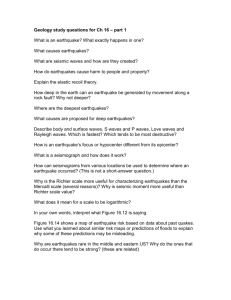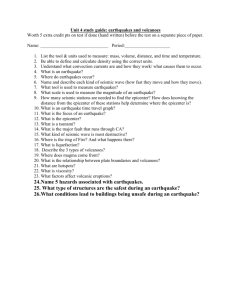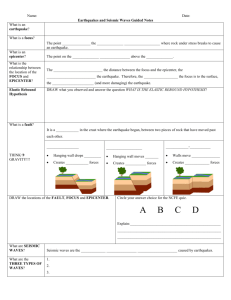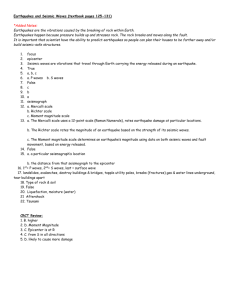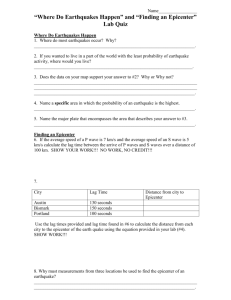Earthquake Basics
advertisement
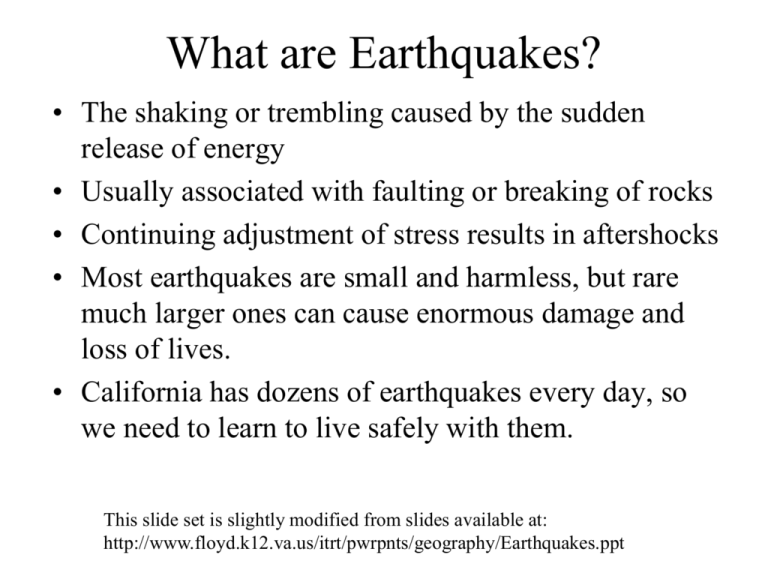
What are Earthquakes? • The shaking or trembling caused by the sudden release of energy • Usually associated with faulting or breaking of rocks • Continuing adjustment of stress results in aftershocks • Most earthquakes are small and harmless, but rare much larger ones can cause enormous damage and loss of lives. • California has dozens of earthquakes every day, so we need to learn to live safely with them. This slide set is slightly modified from slides available at: http://www.floyd.k12.va.us/itrt/pwrpnts/geography/Earthquakes.ppt What is the Elastic Rebound Theory? Explains how energy is stored in rocks • Rocks bend elastically until the strength of the rock is exceeded • Rupture occurs and the rocks quickly rebound to nearly an undeformed shape • Energy is released in several types of waves that radiate outward from the fault at different speeds The Focus and Epicenter of an Earthquake • The point within the earth where faulting begins is the focus, or hypocenter • The point on the surface of the earth directly above the focus is the epicenter Where Do Earthquakes Occur and How Often? ~80% of all earthquakes occur in the circum-Pacific belt – Most of these result from convergent margin activity – About 15% occur in the Mediterranean-Asiatic belt – Remaining 5% occur in the interiors of plates and on spreading ridge centers – More than 150,000 quakes strong enough to be felt are recorded each year How are Earthquakes Located? Seismographs record earthquake events Earthquakes occur at various depths in the earth. At convergent plate boundaries, focal depth increases along a dipping seismic zone called a Benioff zone. The Economic and Societal Impacts of Earthquakes • Building and road collapse • Fire • Tsunami • Landslides • Contamination Damage in Oakland, CA, 1989 Seismic Body Waves: P and S waves • Body waves – P or primary waves • fastest waves • travel through solids, liquids, or gases • compressional wave, material movement is in the same direction as wave movement – S or secondary waves • slower than P waves • travel through solids only • shear waves - move material perpendicular to wave movement Seismic Surface Waves: R and L waves • Surface Waves – Travel just below or along the ground’s surface – Slower than body waves; rolling and side-to-side movement – Especially damaging to buildings How is an Earthquake’s Epicenter Located? Seismic wave behavior – P waves arrive first, then S waves, then L and R – Average speeds for all these waves is known – After an earthquake, the difference in arrival times at a seismograph station can be used to calculate the distance from the seismograph to the epicenter. How is an Earthquake’s Epicenter Located? Time-distance graph showing the average travel times for P- and Swaves. The farther away a seismograph is from the focus of an earthquake, the longer the interval between the arrivals of the P- and S- waves How is an Earthquake’s Epicenter Located? • At least three seismograph stations are needed to locate the epicenter of an earthquake • A circle where the radius equals the distance to the epicenter (from P-S wave separation) is drawn • The intersection of the circles locates the epicenter • In practice, many seismographs from a wide area are used to locate earthquake epicenters How are the Size and Strength of an Earthquake Measured? • • Shaking Intensity – subjective measure of the kind of damage done and people’s reactions to it – isoseismal lines identify areas of equal intensity Modified Mercalli Intensity Map – 1994 Northridge, CA earthquake, magnitude 6.7 How are the Size and Strength of an Earthquake Measured? • Richter Magnitude – Richter scale measures the total amount of energy released by an earthquake; independent of intensity – Amplitude of the largest wave produced by an event is corrected for distance and assigned a value on an open-ended logarithmic scale – For very large earthquakes, a modified Richter scale is used that takes into account the size of the failure surface as well as the amplitude of the seismic waves What are the Destructive Effects of Earthquakes? • Ground Shaking – amplitude, duration, and damage increases in poorly consolidated rocks Can Earthquakes be Predicted? Earthquake “Prediction” Programs – include laboratory and field studies of rocks before, during, and after earthquakes – monitor activity along major faults – produce risk assessments, not specific quake predictions Can Earthquakes be Predicted? Earthquake Precursors – changes in elevation or tilting of land surface, fluctuations in groundwater levels, magnetic field, electrical resistance of the ground – seismic dilatancy model – seismic gaps Can Earthquakes be Controlled? • Graph showing the relationship between the amount of waste injected into wells per month and the average number of Denver earthquakes per month • Some have suggested that pumping fluids into seismic gaps will cause small earthquakes while preventing large ones • How many M6 earthquakes would be needed to release the energy of one M7 earthquake? California has Numerous Earthquakes Every Day http://www.data.scec.org/recenteqs.html • Fortunately, most are small and cause no damage. Most can barely be felt even at the epicenter. • Daily updates of seismic activity in California and Nevada are available from several sources, including the one cited below.



